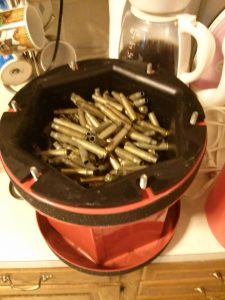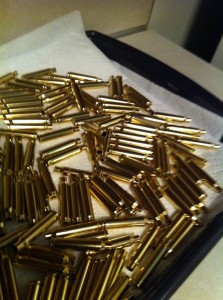 I think there have been HUGE advances in the discussion of SS media brass cleaning. I know my learning curve was logarithmic. Lots of people have submitted some very good data and findings. Really got me thinking.
I think there have been HUGE advances in the discussion of SS media brass cleaning. I know my learning curve was logarithmic. Lots of people have submitted some very good data and findings. Really got me thinking.
There have been a lot of threads on the internet about SS media tumbling and various finding, problems, and solutions. Here is what I have found personally. I think this is the coolest tool for cleaning just about anything metal. I not only use mine for brass but it works great for vintage guitar parts too!!
I have a Thumbler tumbler and I use pins I purchased from these guys.
http://myworld.ebay.com/skilam/
I love my pins. They are perfect and appear to be very high quality. I started with 5 lbs.
My goal has been to be able to clean brass to two levels.
1. Clean range brass for processing- This is when I load up the unit with a lot of cases. I never really tumble long enough to damage the brass. The cases get very clean inside and out… especially compared to walnut or corn tumbling.
2. Clean brass to “like new”- this includes the primer pocket being completely clean. That lead or whatever is in that pocket from the primer is stubborn…
That’s why I started playing with the pin ratio. The case mouth peening is real (although I am making 223 from de milled Lake City 223 right now and every mouth is peened… yes that’s right… they clean after trimming at Lake City…) I am convinced the damage comes from the case on case collisions, not the pins at all…
I promise I will do some work and post the results.
Anyway… This is what I found. I use water, Dawn, and about a half a teaspoon of Lemishine. You don’t need Lemishine but the cases come out noticeably prettier and shinier with it. I have recently started playing with ratios of brass to pins and tumbling time based on reviews and feedback from other users on the forums. People had complained about the necks getting peening at the mouth. I too had witnessed this myself. I have had it so bad on my 6Br cases it wouldn’t let the bullet seat. That was back when I was doing long cycles with lots of brass. Those cases had a VLD inside ream so the mouths were very thin. I think it is far less evident on say LC cases that are cut at a 90 in trim and never really champferred. It like makes the mouth look like a trumpet or flared.
Many theorized that the brass colliding with itself was causing the peening. I think I am going to agree. I think that people are trying to do too many cases at once. I did a test recently and using my 5 lbs of pins I cleaned 50 308 cases. I only had to tumble for about 45 minutes in my 5 lbs of pins to get the cases completely clean inside and out. I saw no real peening that concerned me at all. Nothing like I had seen when I was doing 200 6BR cases at a time and tumbling for 3 hours and the cases were just as clean.
Long story short… clean as few cases as possible or buy more pins. I think the brass has to be swamped by pins and the cases need to be buried and separated as much as possible from the other brass if peening is a concern.
I doubled my pins to 10 pounds. Or you could use 5 lbs of pins and use smaller batches of brass. It does the same thing. My point is that most people are using too much brass to pins and the peening is coming from the brass on brass contact not from the pins. The pins are very, very gentle and work better to more the brass is buried in the pins. Cleaning the brass inside is better in smaller batches.
I am going to say the ratio that is the most efficient as about 100 223 or 50 308/6br cases per 5 lbs of pins. Tumble for about an hour or less.
It is definitely more effective. Period. Small batches take less time and the peening is reduced significantly. Primer pockets clean much faster.
I am cleaning 223 from the ground to like new in one hour. I fill the Thumbler 2/3 full. Nearly exactly 250 cases. But the brass is clean is one hour. Very clean.
Rinsing in denatured alcohol fixes all rinse problems and shortens drying time to half an hour. I dry my cases at 180 degrees in my convection oven 🙂

![My Stainless Steel Media Thumbler Brass Case Cleaning Findings I think there have been HUGE advances in the discussion of SS media brass cleaning. I know my learning curve was logarithmic. Lots of people have submitted some very good […]](https://theurbanrifleman.com/wp-content/uploads/2013/04/CAM001371-480x300.jpg)








Great article! I just started using a STM tumbler and began encountering the same case mouth flare issue. Have been reloading 6mmBR for years and never saw this problem before. I’ve been following the machine instructions which say to tumble for 2-4 hours. I went the full 4 hours because I wanted my brass really shiny. To fix the problem, I turned down the flare with a neck trimmer. This just aggravated the problem. The flaring appears to get worse with longer peening on thin case mouths.
For my serious brass I only do small batches and doubled the pins. I only use about 30 minutes.
I only tumble about half an hour. And keep the batch very small.
During my years in the Navy, we used various methods for parts cleaning and surface prep on a daily basis. Ultrasound, tumbling, vibratory, steam, solvent, bead-blasting etc, all have there pro’s and con’s. Fortunately, we had specific methodology for each application that had been laboratory tested prior to fleet implementation and was constantly improved upon based on fleet feedback. One important factor in tumbling is the level of liquid in the drum. If the liquid level isn’t nearly full, the contact force between the parts (or cases) increases as the liquid level is reduced. With the sloshing associated with lower liquid levels, the speed at which the cases move about inside the drum is much higher than with a nearly full tank. This increased speed is a large contributor to contact damage. I have seen early consumer models instructions had the user only fill the drum until the cases and pins were just covered and not full as is required. This wasn’t addressed in your otherwise good article but should be noted. In certain specialized applications, we sometimes used higher viscosity liquids along with non ferrous media for a gentler process. In the real world, liquids such as ethylene glycol (radiator coolant) and transmission fluid are available options albeit much more expensive options and they would also need an additional cleaning step prior to drying and reloading. I do agree that a higher media to case ratio is the most practical adjustment to prevent the peening as long as the water level in the drum is kept nearly full.
Well said. Thank you.
Stainless Steel Pin Reclaim
The pins can be a real pain to reclaim and not end up in the drain pipe or all over the floor. To collect the pins, use 5 gallon paint strainer mesh (plastic mesh) with an elastic top. The elastic fits nicely over the pail opening, and the mesh pore size is fine enough to capture ALL the pins and allow liquid drainage.
Here is a message I just sent to a seller of “Pin Tumbled Brass”.
This is the first time I have purchased brass that was “Pin Tumbled” and did it give me grief! It seams that the pins used are a perfect fit for the inside of the brass diameter and once they are logged in the brass they cause problems by blocking access to the primer hole when you try to de-prime the brass. The effect of this result in the breakage of de-primer pins. With my RCBS tools this is a fairly simple pin replacement, each pin costing about $1.00. With my Lee tools the entire seizer peace must be replaced. After breaking 3 pins in my RCBS tool and 2 in my Lee tool I finally checked and found the problem was being caused by the tumbling pins that you use. In fact in the 7 Lbs. of brass I found 58 of these pins! It seams that for 223 brass the pins should be half as long or 1.5 times as long to not cause this problem. As a result of this problem I am out of pocket for about $25.00. Do you sell any 223 brass that has not been cleaned using these pins?
As you can tell I had to pay for this lesson and want to warn others about this potential problem.